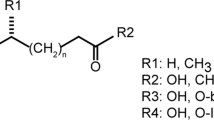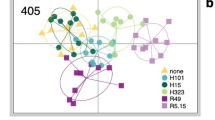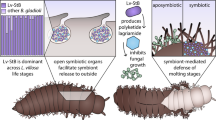Abstract
Survival of nematode species depends on how successfully they disperse in the habitat and find a new host. As a new strategy for collective host finding in the nematode Pristionchus pacificus, dauer larvae synthesize an extremely long-chain polyunsaturated wax ester (nematoil) that covers the surface of the animal. The oily coat promotes congregation of up to one thousand individuals into stable 'dauer towers' that can reach a beetle host more easily.
This is a preview of subscription content, access via your institution
Access options
Subscribe to this journal
Receive 12 print issues and online access
$259.00 per year
only $21.58 per issue
Buy this article
- Purchase on Springer Link
- Instant access to full article PDF
Prices may be subject to local taxes which are calculated during checkout




Similar content being viewed by others
Change history
19 March 2014
In the version of this article initially published online, the legend to Figure 4c describing step e incorrectly stated that 1 equiv. 3 was added when it should have been 1 equiv. 2. The error has been corrected for the HTML version of this article.
References
Riddle, D.L. 12 The Dauer Larva. Cold Spring Harbor Monograph Archive 17 (1988).
Ogawa, A. & Sommer, R.J. Developmental biology. Strategies to get arrested. Science 326, 944–945 (2009).
Albert, P.S. & Riddle, D.L. Mutants of Caenorhabditis elegans that form dauer-like larvae. Dev. Biol. 126, 270–293 (1988).
Croll, N.A. & Matthews, B.E. Biology of nematodes (Blackie & Son Limited, 1977).
Brown, F.D., D'Anna, I. & Sommer, R.J. Host-finding behaviour in the nematode Pristionchus pacificus. Proc. Biol. Sci. 278, 3260–3269 (2011).
Sommer, R.J. & McGaughran, A. The nematode Pristionchus pacificus as a model system for integrative studies in evolutionary biology. Mol. Ecol. 22, 2380–2393 (2013).
Félix, M.A. & Duveau, F. Population dynamics and habitat sharing of natural populations of Caenorhabditis elegans and C. briggsae. BMC Biol. 10, 59 (2012).
Fuchs, G. Über Parasiten und andere biologisch an die Borkenkäfer gebundene Nematoden. 85. Verhandlung der Gesellschaft Deutscher Naturforscher und Ärzte 2, 688–692 (1914).
Cassada, R.C. & Russell, R.L. The dauerlarva, a post-embryonic developmental variant of the nematode Caenorhabditis elegans. Dev. Biol. 46, 326–342 (1975).
Popham, J.D. & Webster, J.M. An alternative interpretation of the fine structure of the basal zone of the cuticle of the dauerlarva of the nematode Caenorhabditis elegans (Nematoda). Can. J. Zool. 56, 1556–1563 (1978).
Wolfmeier, U. et al. in Ullmann's Encyclopedia of Industrial Chemistry (Wiley-VCH Verlag GmbH & Co. KGaA, 2000).
Okumura, E., Tanaka, R. & Yoshiga, T. Negative gravitactic behavior of Caenorhabditis japonica dauer larvae. J. Exp. Biol. 216, 1470–1474 (2013).
Lee, H. et al. Nictation, a dispersal behavior of the nematode Caenorhabditis elegans, is regulated by IL2 neurons. Nat. Neurosci. 15, 107–112 (2012).
Wharton, D.A., Petrone, L., Duncan, A. & McQuillan, A.J. A surface lipid may control the permeability slump associated with entry into anhydrobiosis in the plant parasitic nematode Ditylenchus dipsaci. J. Exp. Biol. 211, 2901–2908 (2008).
Ogawa, A., Streit, A., Antebi, A. & Sommer, R.J. A conserved endocrine mechanism controls the formation of dauer and infective larvae in nematodes. Curr. Biol. 19, 67–71 (2009).
Brenner, S. The genetics of Caenorhabditis elegans. Genetics 77, 71–94 (1974).
Gems, D. et al. Two pleiotropic classes of daf-2 mutation affect larval arrest, adult behavior, reproduction and longevity in Caenorhabditis elegans. Genetics 150, 129–155 (1998).
Bligh, E.G. & Dyer, W.J. A rapid method of total lipid extraction and purification. Can. J. Biochem. Physiol. 37, 911–917 (1959).
Acknowledgements
We thank all members of the Kurzchalia, Sommer and Knölker labs for helpful discussions. We are grateful to J. Saenz for proofreading the manuscript. We thank the Caenorhabditis Genetics Center for providing C. elegans strains. Work in the Knölker laboratory was supported by the European Science Foundation EuroMembrane Network (DFG grant KN 240/13-1). We thank R. Czerwonka for her experimental support in the synthesis of nematoil and J. Sampaio and O. Lavrynenko for their assistance in MS.
Author information
Authors and Affiliations
Contributions
S.P. and A.O. performed phenotypic and microscopy studies; S.P. performed lipid analysis; A.O. performed the genetic screen; U.S. performed organic synthesis; D.T. performed the experiments with insect host organisms; V.Z. and S.B. performed MS analysis; M.G. and U.S. performed NMR analysis; D.V. performed the electron microscopy studies; S.P., A.O., R.J.S., H.-J.K. and T.V.K. conceived the project and wrote the paper; S.P., A.O., J.-M.V., U.S., M.G., H.-J.K., R.J.S. and T.V.K. designed the experiments; all of the authors discussed the results.
Corresponding authors
Ethics declarations
Competing interests
The authors declare no competing financial interests.
Supplementary information
Supplementary Text and Figures
Supplementary Results, Supplementary Note, Supplementary Table 1 and Supplementary Figures 1–24. (PDF 6443 kb)
Supplementary Video 1
Collective waving of P. pacificus dauer larvae as a dauer tower (AVI 8181 kb)
Supplementary Video 2
P. pacificus dauer larvae secrete surface lipids. (AVI 591 kb)
Rights and permissions
About this article
Cite this article
Penkov, S., Ogawa, A., Schmidt, U. et al. A wax ester promotes collective host finding in the nematode Pristionchus pacificus. Nat Chem Biol 10, 281–285 (2014). https://doi.org/10.1038/nchembio.1460
Received:
Accepted:
Published:
Issue Date:
DOI: https://doi.org/10.1038/nchembio.1460
This article is cited by
-
Small-molecule pheromones and hormones controlling nematode development
Nature Chemical Biology (2017)
-
Ancient gene duplications have shaped developmental stage-specific expression in Pristionchus pacificus
BMC Evolutionary Biology (2015)



